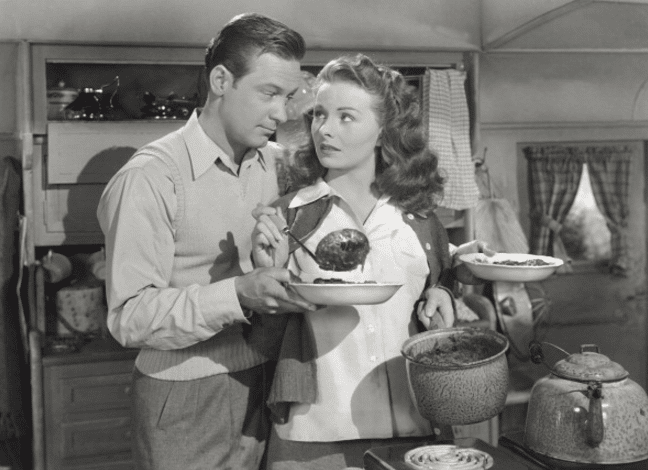
Shacking up. Living in sin.
Fifty years ago, cohabitating with one’s significant other before marriage was described in pejorative terms and often thought of as immoral.
Today the picture is quite different. Living together prior to getting hitched has increased 1500% since the 1960s, and 30% in just the last decade. While almost half of Americans disapproved of the arrangement in 1981, a quarter-century later that number fell to 27%. Today, 2/3 of new marriages are preceded by cohabitation.
Why has living together before marriage become so common? There are several reasons.
The first, of course, is the overall secularization of culture. Living together before marriage naturally signals that a couple is sleeping together before marriage — a violation of the religious proscription against premarital sex. As religious norms have become less dominant in the culture, and adherence to them looser, the societal/familial shame surrounding cohabitation has significantly dropped, while its acceptance has dramatically risen.
Other reasons for the increase in cohabitation rates are more practical. For example, couples often cite the economic benefit — sharing rent, utilities, furniture, etc. — as a motivation for moving in together.
The most popular reason couples decide to live together before marriage, however, is to test their compatibility in the long run — particularly in regards to marriage. Having often grown up as the products of divorce, men and women alike have come to see cohabitation as a low-risk, low-cost way to test out a marriage-like relationship and avoid the pitfalls of their parents. In fact, 2/3 of young adults believe that living together prior to marriage is an effective way to prevent divorce and ensure a happy union.
Does the evidence support that premise?
Answers to this question are often given in unsatisfactory ways. Those with a religious agenda frequently cherry-pick older studies that cast cohabitation in a negative light, while ignoring recent research that offers a more positive take. Yet the proponents of living together can be too dismissive of the significant data which casts doubt on the benefits of cohabitation, instead relying on anecdotal evidence of its positive and protective effect.
The reality, as usual, is a bit more nuanced than most people recognize. The available evidence, in fact, challenges the views of both the pro and con camps.
Today we will thus take a look at both sides of the coin, discussing research conducted only by non-sectarian, non-partisan, academic institutions, and sharing stats both commonly circulated and frequently ignored on the advisability of living together before marriage.
For the religiously devout, the answer to the question of whether to engage in premarital cohabitation is a simple “no.” But for those couples who are less certain of their position, the below aims to be a help in thinking through a question that’s not often taken as seriously as it should be, and in better making an important decision that will greatly impact their individual, and mutual, happiness.
Cohabitation’s Effect on Marriage Stability and Satisfaction
On an intuitive level, it would seem to make sense that couples who had already tried out the proposition of living together, and intimately tested their compatibility, would be able to make a better-informed decision as to whether or not to get hitched, and would thus have a more solid and successful marriage.
Yet, almost a dozen studies conducted since the 1970s have shown the very opposite outcome — that cohabitation prior to marriage is linked to lower marital happiness and stability and a higher chance of divorce. This substantial body of research found that couples who lived together before getting married were in fact 33% more likely to split up than those who didn’t.
Researchers called this paradoxical finding “the cohabitation effect” and frequently surmised that it had more to do with who decided to cohabitate than with cohabitation itself. That is, because more “unconventional” types — folks who were less religious and less committed to the institution of marriage — were more likely to live together before marriage, they were also more likely to seek a divorce if the relationship went sour. The cohabitation effect was thus an issue of correlation, rather than causation.
While plenty of evidence exists to support this theory, most studies still found the cohabitation effect even when controlling for things like religion, politics, and education, leading researchers to conclude that cohabitation itself, rather than simply who practiced it, did have some influence on increasing the chance of divorce and lowering martial satisfaction.
Nonetheless, as cohabitation has become more common, and been picked up by a broader and more conventional swath of the population, its negative impact on divorce has indeed declined, and even disappeared. A recent study that analyzed only those couples that had been married since 1996, found no link between cohabitation before marriage and instability afterward. A 2012 report from the CDC likewise posited “that the association between premarital cohabitation and marital instability for first marriages may have weakened over time because it is less apparent for more recent birth cohorts.”
What’s important to note here, however, is that while there may be emerging evidence that cohabitation isn’t harmful to marriage stability, there isn’t any evidence that it is helpful. It may not increase your chances of getting a divorce, but it doesn’t at all decrease them, either.
Further, even when couples who cohabited before marriage don’t actually split up, there’s evidence to suggest they’re less happy in their marriage than those who moved in after the wedding. Many older studies have found a link between prenuptial cohabitation and a decrease in martial satisfaction, while more recent research showed that, even when controlling for selection factors, married couples who had lived together before getting married (or engaged) “had more negative interactions, lower interpersonal commitment, lower relationship quality, and lower relationship confidence,” and were almost twice as likely to have at some point suggested divorce.
All of this is to say that while it’s popularly thought you would have to be crazy to marry someone you hadn’t lived with before, cohabitation in fact offers no protective value whatsoever, and no advantage over moving in together after walking down the aisle.
As one researcher sums it up: “no positive contribution of cohabitation to marriage has ever been found.”
What accounts for this counterintuitive conclusion?
It may be that cohabitation isn’t actually all that good as practice for marriage. In The Defining Decade, clinical psychologist Meg Jay, who specializes in working with twenty-somethings, observes that living with one’s significant other tends to be more like “an intersection between college roommate and sex partner than a lifelong commitment between two spouses.” She describes the experience of a typical cohabiting couple:
“They vaguely had the idea of testing their relationship, but they didn’t venture into areas that typically stress a marriage: They didn’t pay a mortgage, try to get pregnant, get up in the night with kids, spend holidays with in-laws when they didn’t want to, save for college and retirement, or see each other’s paychecks and credit-card bills.”
“Living with someone may have benefits,” Jay concludes, “but approximating marriage is not necessarily one of them.”
It may also be the case that the positive benefit of getting to know all of a partner’s lifestyle quirks during a period of non-martial cohabitation, are balanced out by the negative relational habits picked up during that time.
Research has shown that “Spouses who cohabited before marriage demonstrated more negative and less positive problem solving and support behaviors compared to spouses who did not cohabit,” a finding that held even when “sociodemographic, intrapersonal, and interpersonal functioning variables” were controlled for. Researchers theorize that because living together before marriage is viewed as a potentially temporary “test drive,” partners are less motivated to really dig in and learn the conflict resolution skills that make for a healthy long-term relationship, and marriage. During the cohabitation period, a pattern of partial commitment, even if subconscious, becomes ingrained, and then is carried over into married life.
An even more significant factor in the decreased satisfaction of spouses who lived together before getting married, is that they may have “settled” for each other — having slid into marriage rather than making a more deliberate decision to get hitched.
Sliding vs. Deciding
Studies have shown that one of the keys to healthy, happy relationships is moving through important transitions deliberately. Whether it’s deciding to have sex, move in together, get married, or have a baby, couples who make these transitions with intentionality — with mutual discussion of meaning, expectations, plans, and purpose — are more likely to flourish.
Unfortunately, prenuptial cohabitation frequently has the effect of dampening the intentionally needed to successfully transition to marriage.
As Jay notes, “Moving from dating to sleeping over to sleeping over a lot to cohabitation can be a gradual slope, one not marked by rings or ceremonies or sometimes even a conversation.”
Research professor Scott Stanley calls this dynamic “sliding vs. deciding.”
Two-thirds of cohabiters are in fact sliders, who didn’t much discuss the decision to move into together. It just kind of happened.
This lack of deliberation may be due to the common view of living together as a fairly low-risk proposition; if things don’t work out, the thinking goes, we’ll just break up and move out. Easy enough.
But while splitting up when you’re living together is certainly logistically and legally easier than getting a divorce, it’s a lot more psychologically difficult than many couples realize. As Jay explains, cohabiters fail to anticipate how factors known in behavioral economics as consumer “lock-in” and “switching costs” operate not only in the marketplace, but in relationships as well, and can make sliding into a relationship a lot harder than sliding out:
“Lock-in is the decreased likelihood to search for other options, or change to another option, once an investment in something has been made. The initial investment, called a setup cost, can be big or small. A form. An entrance fee. The hassle of creating an online account. A down payment on a car. The greater the setup costs, the less likely we are to move to another, even better, situation later. But even a minimal investment can lead to lock-in, especially when we are faced with switching costs. Switching costs—or the time, money, or effort it requires to make a change—are more complex. When we make an initial investment in something, switching costs are hypothetical and in the future, so we tend to underestimate them. It is easy to imagine we’ll just get a new credit card later or deal with breaking a lease when the time comes. The problem is when the time does come, the switching costs seem bigger up close than they did from far away.
Cohabitation is loaded with setup and switching costs, the basic ingredients of lock-in. Moving in together can be fun and economical, and the setup costs are subtly woven in. After years living among a roommate’s junky old stuff, we happily split the rent on a nice one-bedroom apartment. Couples share Wi-Fi and pets and enjoy shopping for new furniture together. Later, these setup costs have an effect on how likely we are to leave.”
Once a couple is set up with a shared apartment, routine, dog, and group of friends, summoning the will to break up becomes more and more difficult. When two lives become so thoroughly intermingled, separating them out, starting all over again, will take a lot of effort; the prospect becomes a little daunting. It seems easier to just keep going with things as they are, even if they’re not ideal. Inertia sets in.
As a result of prematurely “locking in” to one’s roommate/lover, people miss out on opportunities to date those with whom they might be a better fit. As Jay said in an interview, “I have clients who say ‘I spent years of my 20s living with someone who I wouldn’t have dated a year if we had not been living together’”.
More sobering still, is research which suggests that “couples who otherwise would not have married end up married because of the inertia of cohabitation.” They slide their way right down the aisle: “We might as well share an apartment since we’re already spending so much time together” becomes “we might as well stay together since I might not be able to find someone else,” and finally “we might as well get married since we’ve already been living together for so long.”
This may be especially true when the couple is over thirty, and when more and more of their friends start getting hitched. The prospect of finding someone new as the pickings become slimmer, and of being unmarried as everyone else settles down, can motivate couples to stay together, and take, despite misgivings, what seems like the next step in their relationship and lives. A bird in hand seems better than two in the bush.
Jay theorizes that the sliding effect associated with prenuptial cohabitation can ultimately prevent spouses from feeling like they consciously chose each other, leading to more uncertainty, and less happiness, in their marriage:
“Founding a relationship on convenience and ambiguity can interfere with the process of claiming the people we love. We all ought to feel confident we are choosing our partners and our partners are choosing us because we want to be with them, not because staying together is convenient or because breaking up is inconvenient.”
She concludes:
“I am not for or against living together, but I am for twentysomethings knowing that, far from safeguarding against divorce, moving in with someone increases your chances of locking in on someone, whether he or she is right for you or not.”
Conclusion
To summarize the above findings: prenuptial cohabitation neither increases nor decreases your risk of divorce, but may foster an intentionality-dampening dynamic that heightens the risk of entering into a more mediocre union.
The danger of sliding vs. deciding doesn’t necessarily mean you have to wait to live together until you’re married, however.
Studies show that couples who don’t cohabitate serially, only living with the person they end up marrying, and who wait to move in with that person until they get engaged, have the same rate of marriage stability and compatibility as those who only move in together after actually walking down the aisle. The ritual of engagement, having a deliberate plan to marry, carries the kind of ambiguity-slaying intentionality that leads to a happy union.
But, if you’re going to wait to live together until after you’re engaged, why not hold out a little longer and move in after you’ve tied the knot? From an objective standpoint, it won’t have any negative effect whatsoever on your chances for wedded happiness and longevity. From a subjective one, it will enormously enhance the transformative weight of a ritual meant to weld two lives into one. There’s so much sameness in our culture, in our lives, that it pays to intentionally create moments of memorable, meaningful, heightened drama yourself. For it’s one thing to say “I do” and go right back to the same old apartment you’ve been sharing for a long time prior, and another to carry your bride across a threshold into a new abode, a new life, that’s now neither mine nor hers, but ours.
Be sure to listen to our podcast with Scott Stanley for even more on this topic:
Tags: Dating






